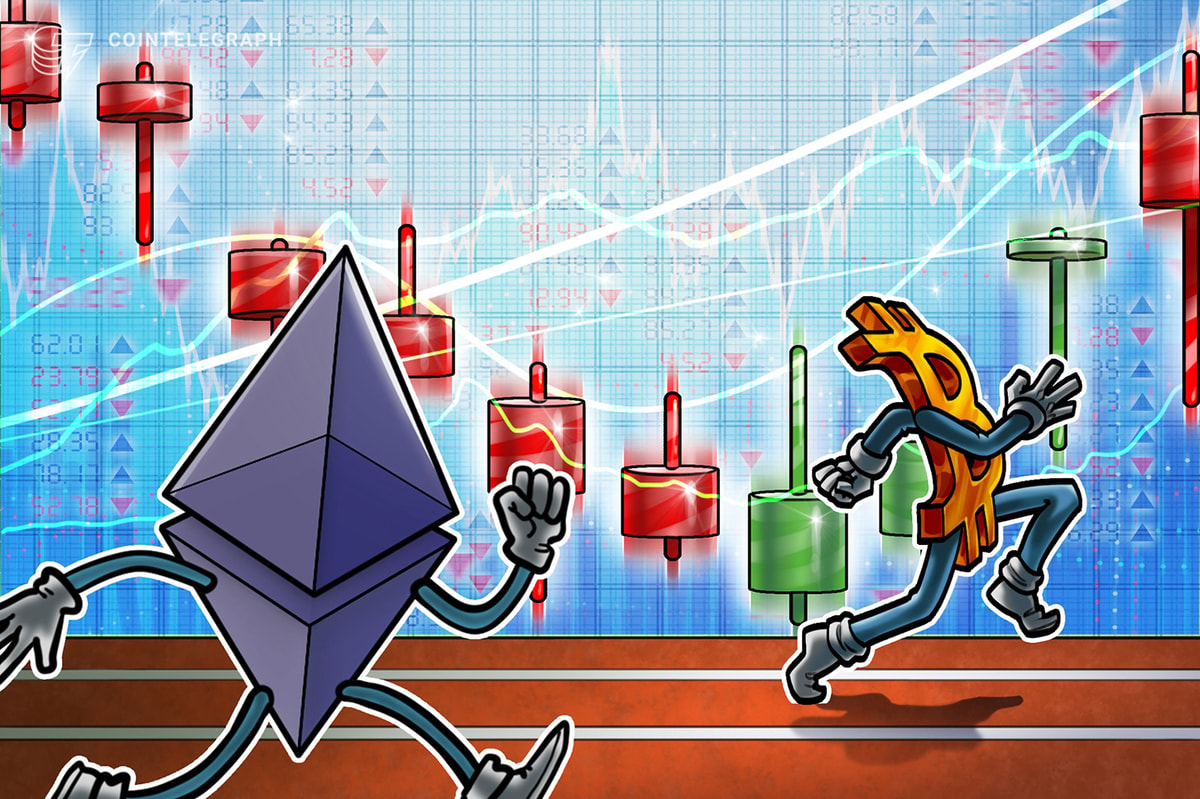A drop in Ethereum network activity and investors’ concerns about the global economy continue to weigh on ETH price.
Markets News
Own this piece of crypto history
Ether (ETH) price fell by 7.3% between Oct. 1 and Oct. 8, wiping out gains made over the previous two weeks. This decline mirrored movements in the broader altcoin market, suggesting that the downturn is not uniquely driven by factors within the Ethereum ecosystem. As a result, traders remain uncertain about Ether’s ability to retake the $2,600 level.
Ether/USD (blue) vs. altcoin market cap (magenta). Source: TradingView
Investor sentiment has been mixed, as Ether has dropped 2% since Sept. 1, while the altcoin market cap has increased by 4.5% during the same period. This discrepancy can partly be attributed to the lackluster debut of Ether exchange-traded funds (ETFs) in the US. These ETFs saw no net inflows on Oct. 7 and have experienced a cumulative outflow of $548 million since their launch in July, according to data from Farside Investors.
Ethereum DApps face stiff competition
Further adding to investor frustration is the growing competition from blockchains prioritizing scalability, such as Solana (SOL), BNB Chain (BNB), Tron (TRX), Avalanche (AVAX), and Sui. Despite criticism over the risk of centralization, these networks have amassed a combined total value locked (TVL) of $19.5 billion, equating to 43% of Ethereum’s $45.6 billion deposits.
Moreover, Ethereum’s dominance in decentralized exchange (DEX) volumes has dropped significantly, from 64% in January 2023 to just 22% currently, with Solana now leading. This trend has cast doubt on Ethereum’s market leadership, leading traders to worry about potential downward pressure on Ether’s price.
Weekly DEX volumes market share. Source: DefiLlama
Ether bulls might contend that Ethereum still holds its leadership position when factoring in layer-2 scaling solutions such as Base, Arbitrum, Polygon, and Optimism. Notably, Base has made significant strides, capturing a 14% market share—an impressive rise from less than 1% just seven months ago.
Key highlights within the Base network include Aerodrome, which facilitated $2.93 billion in trades over the past week, and Uniswap, which saw $1.36 billion in trading volume during the same period. On the Optimism network, the leading decentralized exchange (DEX), Velodrome, registered $360 million in volume, while Camelot on Arbitrum recorded $554 million in trades over the last seven days.
However, layer-2 networks significantly reduce base layer fees by utilizing aggregation techniques and benefiting from the data storage optimization (blob space) introduced in June 2023. Despite the growth of Ethereum’s ecosystem, the number of transactions on the base network has remained relatively stagnant, which partly explains the frustration among Ether investors.
Ethereum number of transactions, 14-day average. Source: Coin Metrics
The sluggish activity on the Ethereum network has led to some undesirable consequences. When there is low competition for processing power, Ether becomes inflationary, as reduced demand for block space and lower transaction fees lessen the incentives for validators to secure the network.
Related: Blockchain activity soars 70% in Q3 driven by AI DApps
BlackRock highlights Ether’s “risk on” value proposition
Unexpectedly, Ether’s potential turning point may have come from a surprising source. On Oct. 3, BlackRock, one of the leading providers of Ether ETFs, emphasized that Ether’s value proposition aligns more with “risk-on” assets, positioning it as a competitor to equities and venture capital. This contrasts with Bitcoin’s core narrative as “digital gold,” according to a post by Bruce Florian, a German Bitcoiner and content creator.
Source: bruceflorian (cropped)
Further complicating the outlook, Daniel Yergin, vice chairman of S&P Global, reportedly told CNBC that the global economy is entering a “dangerous time” due to escalating tensions in the Middle East and reduced oil demand from China. More troubling is the fact that China’s mainland CSI 300 stock market index closed down 9% on Oct. 8, despite the National Development and Reform Commission releasing details of its proposed economic stimulus plan.
With investors showing a diminished appetite for risk and Ethereum facing stiff competition, the likelihood of Ether reclaiming the $2,600 level remains slim, at least in the short term.
This article first appeared at Cointelegraph.com News

